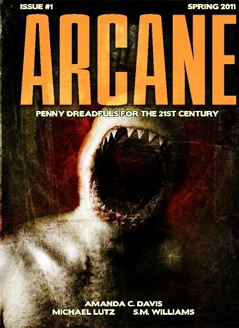 ARCANE is a slick new magazine from Cold Fusion Media and publisher Sandy Petersen. The first issue just dropped and it’s quite a breath of fresh air for horror fans — or should that be a fetid, graveyard breath? Anyway, this new quarterly publication is both an e-mag AND a print mag—it plays no favorites in the “print vs. digital” debate. According to its manifesto ARCANE will be publishing “weird horror, the supernatural, and the fantastic. ” It aims to leave readers highly entertained and slightly disturbed, like the best weird fiction always does.
ARCANE is a slick new magazine from Cold Fusion Media and publisher Sandy Petersen. The first issue just dropped and it’s quite a breath of fresh air for horror fans — or should that be a fetid, graveyard breath? Anyway, this new quarterly publication is both an e-mag AND a print mag—it plays no favorites in the “print vs. digital” debate. According to its manifesto ARCANE will be publishing “weird horror, the supernatural, and the fantastic. ” It aims to leave readers highly entertained and slightly disturbed, like the best weird fiction always does.
Copies are now available on Amazon and the mag’s official site: www.arcanemagazine.com.
Here’s an interview with ARCANE Editor Nathan Shumate, who gives BG the inside track on all the weirdness. Find out where ARCANE came from and where it’s going, as well as what kinds of stories the editor is looking to find.
An Interview With Nathan Shumate
Conducted and Transcribed by John R. Fultz, May 2011
BG: We keep hearing that the “market’s down” — yeah, what else is new? But the market’s also up: E-books are outselling print books on Amazon, millions of dollars spent on books print AND digital. You obviously saw a way to capitalize on both online and print markets when you launched the beast that is ARCANE: PENNY DREADFULS FOR THE 21ST CENTURY. But the question remains: Why start a magazine? What drove you to the mad proposition of launching a fantastic new fiction venue?
ARCANE (Shumate): I originally started the magazine ARKHAM TALES in late 2008; I had always wanted to edit a “weird fiction” magazine, and I realized there was no time like the present. Actually, any time would have been better, as late 2008 was right when the U.S. economy started circling the bowl. The business model I had was a free PDF magazine, paid for with ads, but the ad sales never panned out, and five issues in, I had exhausted the funds on hand to keep the magazine afloat. The magazine was subsequently bought by Leucrota Press, which retained me as editor, but the format stayed the same — even as I realized that a Kindle format, which precluded the inclusion of ads, would have a much larger potential marketshare than a PDF format. Leucrota and I didn’t see eye to eye on that, and I left when the eighth issue was completed, which is right before Leucrota declared bankruptcy. (I swear I had nothing to do with that.)
I had the opportunity to buy back the ARKHAM TALES intellectual property, but I decided to make a clean break rather than spend months deciding which contractual commitments I’d be taking on, and instead formed ARCANE (the name is intentionally reminiscent of that of the former magazine) with Lovecraftian game guru Sandy Petersen, with whom I’ve been acquainted for a few years.
BG: ARCANE crosses the line between fantasy, horror, sci-fi, and more horror. Is genre ultimately meaningless when you find a Great Story to publish?
ARCANE (Shumate) : I think that everything we publish in ARCANE, whether sci-fi, fantasy, or what have you, has cross-pollinated with horror; there is a certain darkness, a certain sense of brooding disquiet, that characterizes our magazine more than out-and-out horror.
…
Read More Read More
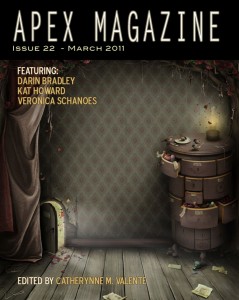 Apex Magazine is a monthly on-line publication of science fiction, fantasy and horror edited by Catherynne M. Valente.
Apex Magazine is a monthly on-line publication of science fiction, fantasy and horror edited by Catherynne M. Valente.
 The June-July 2011
The June-July 2011 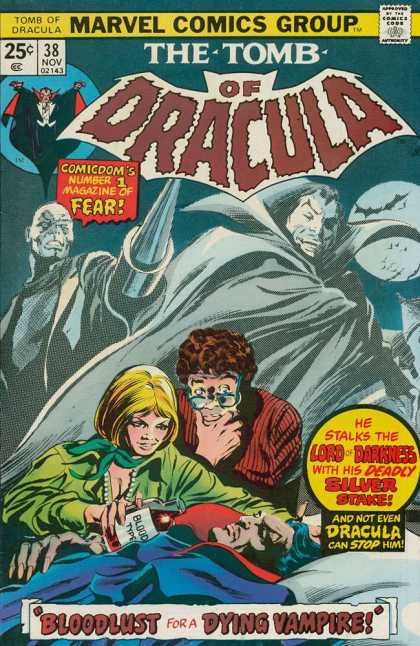
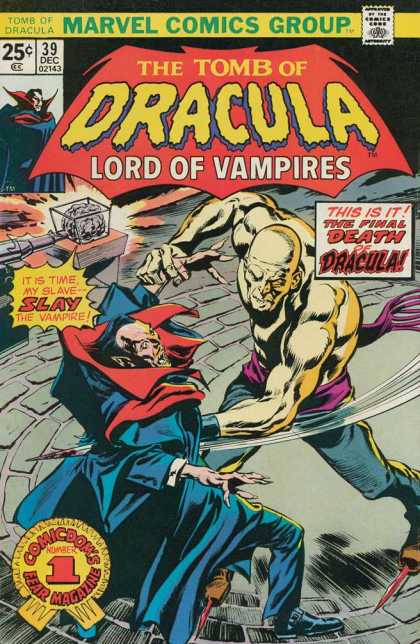
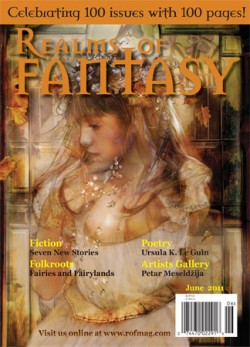 Congratulations to Realms of Fantasy on its 100th issue (which actually has 101 pages, but I guess the extra page is for good luck, and doesn’t make for quite the same alliterative headline), a notable accomplishment for a publication that has been brought back from the dead on several occasions. In fact, the magazine has had five publishers, with founding editor Shawna McCarthy the only person who has been there for the duration, according to the issue’s “Little Known Facts.” Fiction contributors include Leah Bobet, Josh Rountree and Samantha Henderson, Sharon Mock, Thea Hutchinson, Patrick Samphire, Euan Harvey and David D. Levine, as well as poetry by Ursula Le Guin and various art, book, gaming and movie reviews along with the regular Folkroots column by Theodora Gass. Here’s the complete
Congratulations to Realms of Fantasy on its 100th issue (which actually has 101 pages, but I guess the extra page is for good luck, and doesn’t make for quite the same alliterative headline), a notable accomplishment for a publication that has been brought back from the dead on several occasions. In fact, the magazine has had five publishers, with founding editor Shawna McCarthy the only person who has been there for the duration, according to the issue’s “Little Known Facts.” Fiction contributors include Leah Bobet, Josh Rountree and Samantha Henderson, Sharon Mock, Thea Hutchinson, Patrick Samphire, Euan Harvey and David D. Levine, as well as poetry by Ursula Le Guin and various art, book, gaming and movie reviews along with the regular Folkroots column by Theodora Gass. Here’s the complete  Tastemaker Central take particular pleasure in noting that the latter literary bastion has much of interest to the same people who read the bastion of fantasy genre tales (and perhaps vice versa?). The Summer 2011 features “Art of Fiction” interviews with Samuel R. Delany and William Gibson, as well as a story by Jonathan Lethem, “The Empty Room,” that’s available
Tastemaker Central take particular pleasure in noting that the latter literary bastion has much of interest to the same people who read the bastion of fantasy genre tales (and perhaps vice versa?). The Summer 2011 features “Art of Fiction” interviews with Samuel R. Delany and William Gibson, as well as a story by Jonathan Lethem, “The Empty Room,” that’s available 

 I’m beginning to wonder when Interzone will be retitled Jason Sanford’s Interzone; the guy seems to snag the magazine’s featured author slot more times than most. Case in point is the May/June issue in which Sanford’s “Her Scientification, Far Future, Medieval Fantasy” gets top billing, “plus other new stories” by Suzanne Palmer, Lavie Tidhar, Will McIntosh and Jon Ingold. I normally find Sanford intriguing, but this is one of those “I’m in an artificial reality, and I find out that I’m not as real (or more than real) as I thought” stories that is okay but doesn’t add much to the trope that hasn’t already been done before. The first paragraph is a real hoot, though, which I felt the rest of the story didn’t really hold up to:
I’m beginning to wonder when Interzone will be retitled Jason Sanford’s Interzone; the guy seems to snag the magazine’s featured author slot more times than most. Case in point is the May/June issue in which Sanford’s “Her Scientification, Far Future, Medieval Fantasy” gets top billing, “plus other new stories” by Suzanne Palmer, Lavie Tidhar, Will McIntosh and Jon Ingold. I normally find Sanford intriguing, but this is one of those “I’m in an artificial reality, and I find out that I’m not as real (or more than real) as I thought” stories that is okay but doesn’t add much to the trope that hasn’t already been done before. The first paragraph is a real hoot, though, which I felt the rest of the story didn’t really hold up to: ARCANE is a slick new magazine from Cold Fusion Media and publisher Sandy Petersen. The first issue just dropped and it’s quite a breath of fresh air for horror fans — or should that be a fetid, graveyard breath? Anyway, this new quarterly publication is both an e-mag AND a print mag—it plays no favorites in the “print vs. digital” debate. According to its manifesto ARCANE will be publishing “weird horror, the supernatural, and the fantastic. ” It aims to leave readers highly entertained and slightly disturbed, like the best weird fiction always does.
ARCANE is a slick new magazine from Cold Fusion Media and publisher Sandy Petersen. The first issue just dropped and it’s quite a breath of fresh air for horror fans — or should that be a fetid, graveyard breath? Anyway, this new quarterly publication is both an e-mag AND a print mag—it plays no favorites in the “print vs. digital” debate. According to its manifesto ARCANE will be publishing “weird horror, the supernatural, and the fantastic. ” It aims to leave readers highly entertained and slightly disturbed, like the best weird fiction always does.